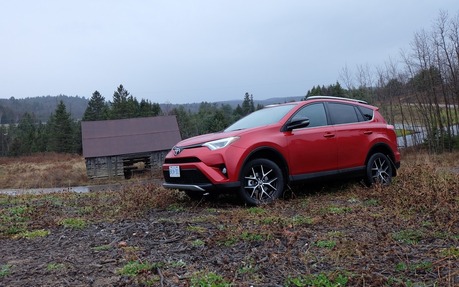2016 Toyota RAV4: Solid Arguments
I’d be wasting my time trying to tell you that compact SUVs are extremely popular right now. We just have to look around on the highway to realize that they surround us, and they’ll probably be a lot of Toyota RAV4s among those. Launched in 1994, the RAV4 really doesn’t have anything to prove anymore, and certain even credit it as being responsible for popularizing the segment.
To make sure the 2016 model year is profitable to their RAV4 – after all, it’s an important model for the brand, and their second best-selling model in Canada after the Corolla –, Toyota invited us in the Ottawa region to present the changes they have made to it. We’re talking here about a refresh and not a new platform, but the 2016 RAV4 does have an ace up its sleeve.
We’ll get back to that.
A more dynamic look
If the styling of Toyota’s products spent many years respecting the status quo, the most recent models are starting to show a little good will. The 2016 RAV4 now sports more angular headlights and the front bumper was flattened to convey a more muscular appearance. Projector-type headlamps are now standard, giving the RAV4 a more modern look while obviously helping visibility at night.
This year, Toyota is offering a new SE variant of the RAV4 as an answer to buyers complaining from a lack of sportiness in the company’s SUVs. It also equipped the SE with standard all-wheel drive and unique 18-inch alloy wheels. No changes to the powertrain; the 2.5-litre four-cylinder engine that develops 176 horsepower and 172 lb-ft of torque is still used, in addition to the six-speed automatic transmission that’s also found in other RAV4 trims.
On the SE, it seems as though sportiness means standard features. It includes a seven-inch infotainment screen, front and rear LED daytime running lights, an eight-way power driver’s seat, a heated steering wheel and heated front seats, among other things. All this “sportiness” has a price: with a starting MSRP of $34,620, the RAV4 SE slots in between the XLE AWD and the Limited.
We’ll promptly mention that the RAV4 SE’s drive isn’t sporty. Between its power – adequate, nothing more – and its suspension tuned to absorb potholes instead of sticking to the pavement, no one will mistake this vehicle with a Scion FR-S. However, I appreciated the quiet ride, the quality of cabin materials (the stitching on the cushioned dashboard looks pretty good) and the interior space, since the RAV4 is the roomiest model in its category. In addition, Toyota states an average consumption of 9.4 L/100km, which is most respectable.
The ace up its sleeve: Hybrid
For those who want to reduce their fuel consumption but still want to benefit from the RAV4’s cargo capacity and all-wheel drive, Toyota is now offering a hybrid variant. Since the Japanese giant is a leader in this domain, it was pretty obviously that a gas-electric RAV4 would see the light of day sooner or later.
Its hybrid powertrain is familiar, as it’s identical to the one found in the Lexus NX 300h. The Atkinson-cycle, 2.5-litre engine is matched to a CVT automatic gearbox and a small electric motor. There’s no driveshaft at the centre of the vehicle; all-wheel traction is provided by a rear-mounted electric motor. All these components develop a combined 194 horsepower, making the RAV4 Hybrid the most fuel-efficient version of the line-up – 6.9 L/100km around town and 7.6 L/100km on the highway, according to Toyota – but also the quickest, which shaves a second off 0-100 km/h acceleration runs compared to its non-hybrid counterparts.
Unsurprisingly, getting behind the wheel of the RAV4 Hybrid feels like a cross between a regular SUV and a Prius. If we’re REALLY soft on the pedal, we can creep away without waking up the gas engine. However, above 40 km/h, it’s impossible to drive on electric power alone. The transition between the combustion engine and electric propulsion is pretty transparent, and the CVT does its job nicely.
Sign of modern times
With the arrival of the RAV4 Hybrid, Toyota is demonstrating once again its intention of being as green as possible. Moreover, one of the admitted objectives of the brand is to reduce its total CO2 emissions – including not only the vehicles on the road, but assembly plants and transport – by 90% by 2050.
For now, the least expensive variant of the RAV4 Hybrid is the XLE, which starts at $34,465. This will give you the added benefits from AWD (very useful for us in Canada), higher ground clearance and greater cargo volume.
| Test drive report | |
| Test model | 2016 Toyota RAV4 |
|---|---|
| Trim level | 4WD Hybrid |
| Price range | $25,920 – $36,000 |
| Price as tested | CA$36,000 |
| Warranty (basic) | 3 years/60,000 km |
| Warranty (powertrain) | 5 years/100,000 km |
| Fuel economy (city/highway/observed) | 7.8 / 7.0 / N/A L/100km |
| Options | N/A |
| Competitive models | Chevrolet Equinox, Ford Escape, GMC Terrain, Honda CR-V, Hyundai Tucson, Jeep Cherokee, Kia Sportage, Mazda CX-5, Mitsubishi Outlander, Nissan Rogue, Subaru Forester, Volkswagen Tiguan |
| Strong points |
|
| Weak points |
|
| Editor's rating | |
| Fuel economy | The RAV4 is frugal, hybrid powertrain or not |
| Comfort | The quality of the cockpit is constantly improving, as is ride quietness |
| Performance | The instantaneous torque provided by the electric motors translates into interesting performance |
| Infotainment | The touchscreen lacks precision, and there are too few physical buttons |
| Driving | Nobody buys a RAV4 for its playful character, sporty trim level or not |
| Overall | With these improvements, the 2016 Toyota RAV4 has what it takes to remain one of the segment leaders |
